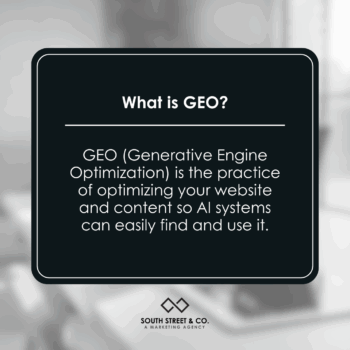TABLE OF CONTENTS
What is GEO? Learn what it is and how it can help your business stay visible, reach the right audience, and optimize content for AI-driven search results.
If you keep up with digital marketing trends, you’ve probably heard the term GEO thrown around — but you might be wondering, what is GEO, and why should I care as a business owner?
In this guide, we’ll break down what GEO is, why it matters, and how you can start using it to make your business more visible in today’s AI-driven search landscape.
What is GEO?
GEO stands for Generative Engine Optimization. It’s the process of designing and structuring your website content so that AI-powered search tools — like Google’s Search Generative Experience (SGE), ChatGPT, and other AI-driven assistants — can easily find, interpret, and cite your business.
Traditional SEO centers around improving your website’s position on search engine results pages (SERPs). GEO goes a step further by ensuring your content is ready for generative AI results, which are becoming the first place people turn when looking for information.
Instead of just appearing in a list of links, your business can show up in AI-driven summaries, responses, or recommendations — giving you a direct path to potential customers.
Why GEO Matters for Business Owners
AI is transforming the way users search for products, services, and information. Many people no longer click through multiple pages — instead, they rely on AI-generated answers that summarize or recommend businesses. If your business isn’t optimized for this type of search, you could be invisible to a growing segment of your audience.
Key benefits of GEO include:
- Increased AI visibility: Your business has a chance to appear in AI-generated responses for relevant queries.
- Enhanced credibility: Being cited by AI systems reinforces your authority and trustworthiness.
- Customer-centric content: GEO encourages answering questions in a clear, structured way that aligns with what customers want to know.
- Competitive advantage: Businesses that adopt GEO early can gain a competitive edge over those using only traditional SEO.
How GEO Works in Practice
GEO isn’t just a buzzword — it’s actionable. The goal is to make your website and content AI-friendly, which means structuring information so generative engines can easily understand and share it.
Here’s how businesses implement GEO:
1. Answer Key Questions Up Front
Generative AI thrives on clear, concise answers. Structure your content to respond to questions your customers are asking directly. This could include FAQs, detailed guides, or step-by-step instructions on your services.
Example: A home service provider might create a section answering, “How often should I have my air ducts cleaned in Orlando?”
2. Use Conversational, Long-Tail Keywords
GEO emphasizes natural language over traditional keyword stuffing. Think about how people actually phrase their questions.
Example: “How do I find a reliable Orlando website design company?” instead of just “website design Orlando.”
3. Focus on E-E-A-T (Experience, Expertise, Authoritativeness, Trustworthiness)
AI systems prioritize credible and trustworthy sources. Make sure your content reflects your business’s experience, cites authoritative sources when relevant, and clearly communicates who you are and what you do.
Example: A law firm might highlight case outcomes, client testimonials, and attorney credentials to show expertise and trustworthiness.
4. Structure Content for Clarity
Use subheaders, bullet points, numbered lists, and short paragraphs to make content easier for both users and AI to read. Clear formatting helps AI understand the hierarchy of information, improving the likelihood that your content will be accurately cited.
Example: A home service provider could create a step-by-step guide for seasonal maintenance with bullet points and headings.
5. Combine GEO With Traditional SEO
GEO builds on SEO; it doesn’t replace it. Fast website speeds, optimized metadata, mobile responsiveness, and high-quality backlinks remain essential. GEO ensures your content is AI-ready, giving you an edge in modern search experiences.
Example: A B2B company might optimize case studies with clear headings, meta descriptions, and structured data so both AI systems and search engines can easily understand and cite them.
FAQ: What Business Owners Ask About GEO
Does GEO replace traditional SEO?
No — GEO enhances it. You still need strong SEO foundations, but GEO ensures your content is optimized for AI-driven search experiences.
Is GEO only relevant for big companies or tech-savvy brands?
Absolutely not. Small businesses, local services, and niche markets can all benefit by structuring content to answer customer questions clearly and credibly.
How quickly can I see results with GEO?
With GEO, results are about direct AI citations and references. When your content is structured to be AI-friendly, generative systems like ChatGPT, Bard, or other AI tools can accurately reference your information in responses. These results can appear as soon as your content is live and structured, even before traditional search rankings shift, giving your business early visibility in AI-driven search experiences.
Do I need to overhaul my website to implement GEO?
Not necessarily. Many GEO strategies involve updating existing content, structuring FAQs, and optimizing metadata. A full website redesign may help, but it isn’t always required.
Final Thoughts
So, what is GEO? In short, it’s the next evolution of SEO for an AI-driven world. By making your content easy for AI systems to find, understand, and cite, your business can stay visible and relevant as search habits shift.
If you want to future-proof your marketing strategy and ensure your website is optimized for AI search, contact us today to book a complimentary call. We’ll help you identify GEO opportunities tailored to your business and keep you ahead of the competition.







